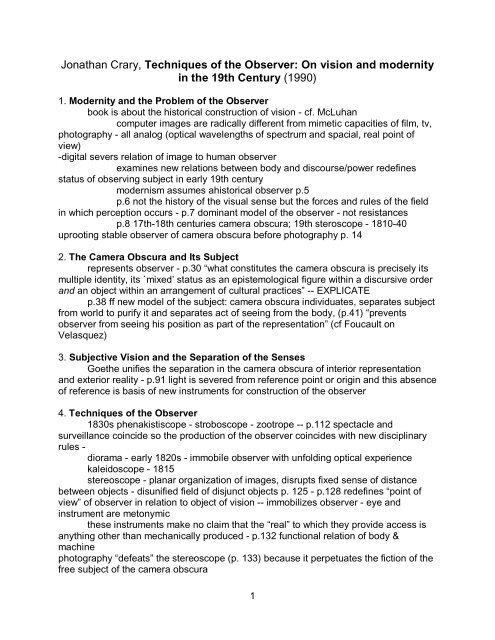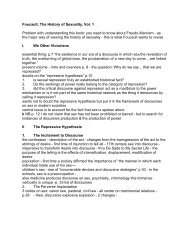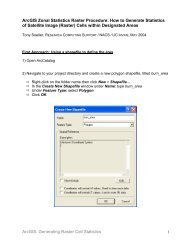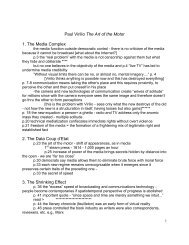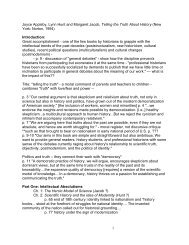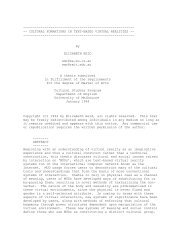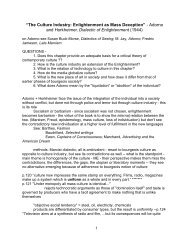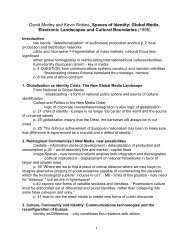Jonathan Crary, Techniques of the Observer: On vision and ...
Jonathan Crary, Techniques of the Observer: On vision and ...
Jonathan Crary, Techniques of the Observer: On vision and ...
Create successful ePaper yourself
Turn your PDF publications into a flip-book with our unique Google optimized e-Paper software.
<strong>Jonathan</strong> <strong>Crary</strong>, <strong>Techniques</strong> <strong>of</strong> <strong>the</strong> <strong>Observer</strong>: <strong>On</strong> <strong>vision</strong> <strong>and</strong> modernity<br />
in <strong>the</strong> 19th Century (1990)<br />
1. Modernity <strong>and</strong> <strong>the</strong> Problem <strong>of</strong> <strong>the</strong> <strong>Observer</strong><br />
book is about <strong>the</strong> historical construction <strong>of</strong> <strong>vision</strong> - cf. McLuhan<br />
computer images are radically different from mimetic capacities <strong>of</strong> film, tv,<br />
photography - all analog (optical wavelengths <strong>of</strong> spectrum <strong>and</strong> spacial, real point <strong>of</strong><br />
view)<br />
-digital severs relation <strong>of</strong> image to human observer<br />
examines new relations between body <strong>and</strong> discourse/power redefines<br />
status <strong>of</strong> observing subject in early 19th century<br />
modernism assumes ahistorical observer p.5<br />
p.6 not <strong>the</strong> history <strong>of</strong> <strong>the</strong> visual sense but <strong>the</strong> forces <strong>and</strong> rules <strong>of</strong> <strong>the</strong> field<br />
in which perception occurs - p.7 dominant model <strong>of</strong> <strong>the</strong> observer - not resistances<br />
p.8 17th-18th centuries camera obscura; 19th steroscope - 1810-40<br />
uprooting stable observer <strong>of</strong> camera obscura before photography p. 14<br />
2. The Camera Obscura <strong>and</strong> Its Subject<br />
represents observer - p.30 “what constitutes <strong>the</strong> camera obscura is precisely its<br />
multiple identity, its `mixed’ status as an epistemological figure within a discursive order<br />
<strong>and</strong> an object within an arrangement <strong>of</strong> cultural practices” -- EXPLICATE<br />
p.38 ff new model <strong>of</strong> <strong>the</strong> subject: camera obscura individuates, separates subject<br />
from world to purify it <strong>and</strong> separates act <strong>of</strong> seeing from <strong>the</strong> body, (p.41) “prevents<br />
observer from seeing his position as part <strong>of</strong> <strong>the</strong> representation” (cf Foucault on<br />
Velasquez)<br />
3. Subjective Vision <strong>and</strong> <strong>the</strong> Separation <strong>of</strong> <strong>the</strong> Senses<br />
Goe<strong>the</strong> unifies <strong>the</strong> separation in <strong>the</strong> camera obscura <strong>of</strong> interior representation<br />
<strong>and</strong> exterior reality - p.91 light is severed from reference point or origin <strong>and</strong> this absence<br />
<strong>of</strong> reference is basis <strong>of</strong> new instruments for construction <strong>of</strong> <strong>the</strong> observer<br />
4. <strong>Techniques</strong> <strong>of</strong> <strong>the</strong> <strong>Observer</strong><br />
1830s phenakistiscope - stroboscope - zootrope -- p.112 spectacle <strong>and</strong><br />
surveillance coincide so <strong>the</strong> production <strong>of</strong> <strong>the</strong> observer coincides with new disciplinary<br />
rules -<br />
diorama - early 1820s - immobile observer with unfolding optical experience<br />
kaleidoscope - 1815<br />
stereoscope - planar organization <strong>of</strong> images, disrupts fixed sense <strong>of</strong> distance<br />
between objects - disunified field <strong>of</strong> disjunct objects p. 125 - p.128 redefines “point <strong>of</strong><br />
view” <strong>of</strong> observer in relation to object <strong>of</strong> <strong>vision</strong> -- immobilizes observer - eye <strong>and</strong><br />
instrument are metonymic<br />
<strong>the</strong>se instruments make no claim that <strong>the</strong> “real” to which <strong>the</strong>y provide access is<br />
anything o<strong>the</strong>r than mechanically produced - p.132 functional relation <strong>of</strong> body &<br />
machine<br />
photography “defeats” <strong>the</strong> stereoscope (p. 133) because it perpetuates <strong>the</strong> fiction <strong>of</strong> <strong>the</strong><br />
free subject <strong>of</strong> <strong>the</strong> camera obscura<br />
1
5. Visionary Abstraction<br />
2


